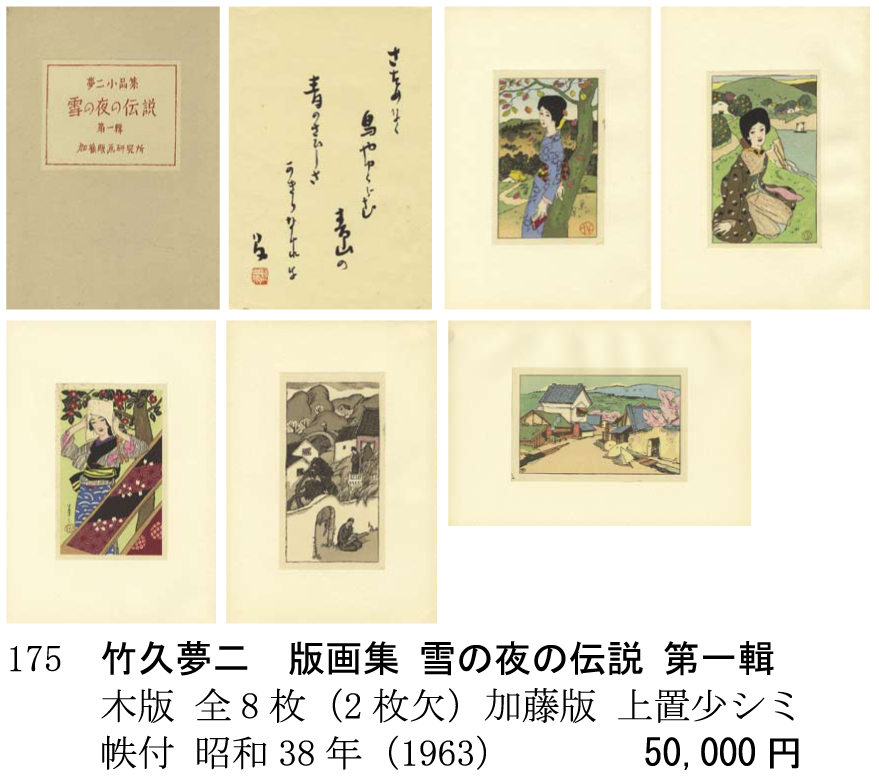About This Print
Source: Revisiting Modern Japanese Prints: Selected Works from the Richard F. Grott Family Collection, Helen M. Nagata, Helen Merritt, Northern Illinois University Art Museum, 2007, p. 15 and 52.
Cove of Oranges features the type of modern Taisho-era (1912-1926) woman for which Yumeji was known: willowy with pensive large eyes suggestive of the women he had loved. Carved and printed with ukiyo-e techniques, the print offers a new Western-tinged definition of the romantic female.
Cove of Oranges depicts a rather pensive, lithe young woman in a lighthearted, colorful style. Sitting on a grassy knoll near a water inlet with cute orange trees and what looks like a sailboat, European-style white houses, and a rising steeple in the background, the young woman looks both relaxed and uncomfortable in her kimono at the same time. The figure and setting give just enough information to capture a moment and create a mystery. Who is she? Where is she? What is she thinking? The illustrative, almost cartoonish quality of the composition combined with the small dimensions of the woodblock print creates a storybook intimacy and fantasy. Here is a charming, youthful woman dressed in traditional Japanese clothing, caught in a graceful pose outdoors as though she were sketched plein air in France. She seems to offer the perfect blend of whimsical naivete and romantic melancholy, and becomes an apt symbol for a “modern” Taisho-era woman caught between Japanese traditions and European Jungenstil (or Art Nouveau) flair. Even the woodblock print itself seems to offer a hybrid nuance resonating as it does in technique with the ukiyo-e tradition while at the same time featuring playful, hatch-mark texturing strokes more akin to an engraving.
Source: Modern Japanese Woodblock Prints - The Early Years, Helen Merritt, University of Hawaii Press, 1998, p. 30.
Cove of Oranges was an illustration first published in the magazine Jogaku sekai (World of Women’s Lessons) in December 1912. In this print a young woman with a long pale face and stylish kimono sits on a grassy knoll above a cliff overlooking an inlet. Trees in the background are heavy with large oranges, suggesting that it is midwinter in a balmy southern port. In 1963 Kato Junji issued this print in a set with six other woodblock prints [actually four other, as total set was five prints, as shown below] as a collection of small works by Yumeji titled Legends of Snowy Nights 雪の夜の伝話(see below).
Also see the prints untitled landscape with village and two women and Village in Spring in this collection.
雪の夜の伝説
Print Details
| IHL Catalog | #344 |
| Title | Cove of Oranges |
| Series | n/a |
| Artist | Takehisa Yumeji (1884-1934) |
| Signature | unsigned |
| Seal | Mark resembling a tulip (red circle, red lines) at lower right on image |
| Publication Date | 1963 [Cove of Oranges was an illustration first published in the magazine Jogaku sekai (World of Women’s Lessons) in December 1912.] |
| Edition | from the 1963 portfolio of five small prints (pictured above) |
| Publisher | Katō Junji |
| Impression | excellent |
| Colors | excellent |
| Condition | excellent |
| Genre | fukusei hanga |
| Miscellaneous | |
| Format | |
| H x W Paper | 7 7/8 x 5 in. (20 x 12.7 cm) |
| H x W Image | 7 1/4 x 4 5/8 in. (18.4 x 11.7 cm) |
| Collections This Print | Northern Illinois University Art Museum NIU 2005.43 |
| Reference Literature | Revisiting Modern Japanese Prints: Selected Works from the Richard F.Grott Family Collection, Helen M. Nagata, Helen Merritt, NorthernIllinois University Art Museum, 2007, p. 56 color plate and p. 85 #21; Modern JapaneseWoodblock Prints - The Early Years, Helen Merritt, University of Hawaii Press, 1998,color plate 1. |



